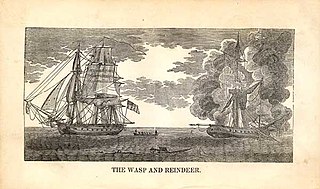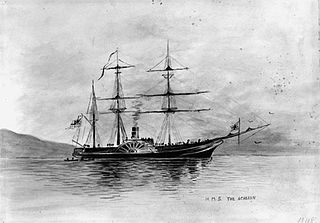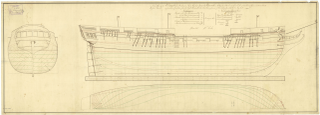
HMS Reindeer was a Royal Navy 18-gun Cruizer-class brig-sloop of the Royal Navy, built by Samuel & Daniel Brent at Rotherhithe and was launched in 1804. She was built of fir, which made for more rapid construction at the expense of durability. Reindeer fought in the Napoleonic Wars before succumbing in 1814 to the guns of USS Wasp during the War of 1812.
Launched on 21 May 1797, GB No. 21 was renamed HMS Defender on 7 August the same year. She was a 12-gun Courser-class gun-brig built for the British Royal Navy at Limehouse and disposed of in 1802.

The Cherokee class was a class of brig-sloops of the Royal Navy, mounting ten guns. Brig-sloops were sloops-of-war with two masts rather than the three masts of ship sloops. Orders for 115 vessels were placed, including five which were cancelled and six for which the orders were replaced by ones for equivalent steam-powered paddle vessels.

The Cruizer class was an 18-gun class of brig-sloops of the Royal Navy. Brig-sloops were the same as ship-sloops except for their rigging. A ship-sloop was rigged with three masts whereas a brig-sloop was rigged as a brig with only a fore mast and a main mast.
The Crocus-class brig-sloops were a class of sloop-of-war built for the Royal Navy, and were the only Royal Navy brig-sloops ever designed rated for 14 guns. The class was designed by the Surveyors of the Navy jointly, and approved on 28 March 1807. Unlike the vast majority of other British brig-sloops built for the Royal Navy in this wartime period, which were built by contractors, construction of the Crocus class was confined to the Admiralty's own dockyards. One vessel was ordered from each of the Royal Dockyards on 30 March 1807; four more were ordered during 1808 and a final unit in 1810. All the ships of the class survived the Napoleonic Wars and were broken up between 1815 and 1833.

The Seagull class were built as a class of thirteen 16-gun brig-sloops for the Royal Navy, although an extra 2 carronades were added soon after completion. The class was designed by one of the Surveyors of the Navy - Sir William Rule - and approved on 4 January 1805. Five vessels to this design were ordered in December 1804; eight more were ordered in the summer of 1805.

The Cormorant class were built as a class of 16-gun ship sloops for the Royal Navy, although they were re-rated as 18-gun ships soon after completion.
The Swan class were built as a 14-gun class of ship sloops for the Royal Navy, although an extra two guns were added soon after completion.

The Diligence class were built as a class of eight 18-gun brig-sloops for the Royal Navy. They were originally to have carried sixteen 6-pounder carriage guns, but on 22 April 1795 it was instructed that they should be armed with sixteen 32-pounder carronades, although two of the 6-pounders were retained as chase guns in the bows. Consequently they were classed as 18-gun sloops. However, in service it was found that this armament proved too heavy for these vessels, and so in most vessels the 32-pounder carronades were replaced by 24-pounder ones.

The Albatross class were built as a class of eight 18-gun brig-sloops for the Royal Navy. They were originally to have carried sixteen 6-pounder carriage guns, but on 22 April 1795 it was instructed that they should be armed with sixteen 32-pounder carronades, although two of the 6-pounders were retained as chase guns in the bows. Consequently, they were classed as 18-gun sloops. However, in service it was found that this armament proved too heavy for these vessels, and so in most vessels the 32-pounder carronades were replaced by 24-pounder ones.

On 26 March 1846, two vessels were ordered from Deptford Dockyard as Rifleman-designed gunvessels named Archer and Parthian. However, on 9 September 1846 the orders for both vessels were suspended prior to the vessels being laid down. On 25 April 1847 two vessels were ordered to the improved Rattler-type screw sloops as designed by John Edye of the Surveyor's Department from Deptford Dockyard. The first vessel, Archer may have been the change of the build from the Rifleman type to the sloop design. The second vessel, Wasp, appears to be a new vessel as the build for the Parthian remained on the books at Deptford until June 1849, when it was cancelled. Archer received the machinery from the gunvessel Rifleman, which resulted in an increase of speed over Wasp. Wasp's hull was sheathed in Muntz metal to retard marine growth. Their armament would increase from 12 to 15 guns over their careers. Both vessels would participate in the Russian War of 1854–1855. Both would be broken by 1869.

The Hermes class were a group of four vessels designed by John Edye of the Surveyor's Department to specifications outlined by Captain William Symonds, the Surveyor of the Navy. The design was approved in 1834. The vessels would be powered by a 140 nominal horsepower engine and carry an armament of two brass 9-pounder guns. The ships would be built in three Royal Dockyards, however, the Chatham vessel was transferred to Sheerness in 1837 prior to being laid down. Hermes was re-engined and lengthen in 1842, Megaera was wrecked in Jamaica in 1843. the remaining vessels served on many different stations of the Empire. Acheron was sold in 1855, Hermes went to the Breakers in 1864 and Volcano lasted until 1894.
The Snake-class ship-sloops were a class of four Royal Navy sloops-of-war built in the late 18th and early 19th centuries. Though ships of the class were designed with the hull of a brig, their defining feature of a ship-rig changed their classification to that of a ship-sloop rather than that of a brig-sloop.

The Thames-class frigate was a 32-gun fifth-rate frigate class of eight ships of the Royal Navy based on the Richmond-class frigate designed by William Bately. The ships were ordered to the older design, which was of a smaller type of ship compared to more modern designs, so that they could be built quickly and cheaply in time to assist in defending against Napoleon's expected invasion of Britain. The class received several design changes to the Richmond class, being built of fir instead of oak, with these changes making the class generally slower and less weatherly than their predecessors, especially when in heavy weather conditions. The first two ships of the class, Pallas and Circe, were ordered on 16 March 1804 with two more ordered on 1 May and the final four on 12 July. The final ship of the class, Medea, was cancelled on 22 October before construction could begin but the other seven ships of the class were commissioned between 1804 and 1806.
The Stromboli class was a group of two vessels designed by Sir William Symonds the Surveyor of the Navy. The design was approved on 29 August 1838. The vessels were of the Medea design but were altered to the new draught derived from the Gorgon. The ships were initially classified as Steam Vessels Second Class (SV2) and were later classified as First Class sloops. The ships were built in two Royal Dockyards. Both ships were at the bombardment of Acre in 1840. Both were in the Black and Azov seas during the Russian War. They served on various stations of the Empire. Vesuvius was sold in 1865 and Stromboli in 1866. Both were broken by White at East Cowes on the Isle of Wight.
The Bulldog-class steam vessels (SV2) later reclassed as First Class Sloops, were designed by Sir William Symonds, the Surveyor of the Navy. Designed from the Driver class by Admiralty Order of 26 December 1843, the design was approved in 1844. The changes included lengthening the bow by 10 feet to provide 6 feet of extra space in the engine room. Three vessels would have a single funnel whereas Scourge would have two and be completed as a bomb vessel. In July 1844 it was queried if Fury was to be completed as a screw vessel, however, since her construction was well along she would be completed as a paddle steamer. Four vessels were ordered and completed.

The Perseverance-class frigate was a 36-gun, later 42-gun, 18-pounder fifth-rate frigate class of twelve ships of the Royal Navy, constructed in two batches. Designed by Surveyor of the Navy Sir Edward Hunt the first iteration, consisting of four ships, was constructed as a rival to the similar Flora-class frigate. Strongly built ships, the Perseverance class provided favourable gunnery characteristics and was highly manoeuvrable, but bought these traits with a loss of speed. The name ship of the class, Perseverance, was ordered in 1779 and participated in the American Revolutionary War, but her three sister ships were constructed too late to take part. The class continued in service after the war, but soon became outdated.

The Narcissus-class frigate was a 32-gun, 18-pounder fifth-rate frigate class of five ships of the Royal Navy. Designed by Surveyor of the Navy Sir John Henslow, the class was created to make use of shipyards that could not construct larger frigates. They were similar in design to the preceding 32-gun frigate class, the Amphion class, but were slightly shorter. Two ships were initially constructed, with a later batch of three being ordered in response to an Admiralty request for the resumption of production of proven frigate designs. The final two ships of the class were cancelled when the shipyard they were being constructed at went bankrupt. Unlike her sister ships, the name ship of the class Narcissus was armed with experimental short 24 pounders rather than 18 pounders.











